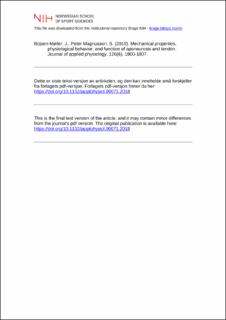| dc.contributor.author | Bojsen-Møller, Jens | |
| dc.contributor.author | Peter Magnusson, S | |
| dc.date.accessioned | 2020-06-24T08:46:08Z | |
| dc.date.available | 2020-06-24T08:46:08Z | |
| dc.date.created | 2019-08-27T15:16:06Z | |
| dc.date.issued | 2019 | |
| dc.identifier.citation | Journal of applied physiology. 2019, 126(6), 1800-1807. | en_US |
| dc.identifier.issn | 8750-7587 | |
| dc.identifier.uri | https://hdl.handle.net/11250/2659250 | |
| dc.description | I Brage finner du siste tekst-versjon av artikkelen, og den kan inneholde ubetydelige forskjeller fra forlagets pdf-versjon. Forlagets pdf-versjon finner du på journals.physiology.org / In Brage you'll find the final text version of the article, and it may contain insignificant differences from the journal's pdf version. The definitive version is available at journals.physiology.org. | en_US |
| dc.description.abstract | During human movement, the muscle and tendinous structures interact as a mechanical system in which forces are generated and transmitted to the bone and energy is stored and released to optimize function and economy of movement and/or to reduce risk of injury. The present review addresses certain aspects of how the anatomical design and mechanical and material properties of the force-transmitting tissues contribute to the function of the muscle-tendon unit and thus overall human function. The force-bearing tissues are examined from a structural macroscopic point of view down to the nanoscale level of the collagen fibril. In recent years, the understanding of in vivo mechanical function of the force-bearing tissues has increased, and it has become clear that these tissues adapt to loading and unloading and furthermore that force transmission mechanics is more complex than previously thought. Future investigations of the force-transmitting tissues in three dimensions will enable a greater understanding of the complex functional interplay between muscle and tendon, with relevance for performance, injury mechanisms, and rehabilitation strategies. | en_US |
| dc.language.iso | eng | en_US |
| dc.subject | force-transmitting tissues | en_US |
| dc.subject | muscle-tendon unit | en_US |
| dc.title | Mechanical properties, physiological behavior, and function of aponeurosis and tendon | en_US |
| dc.type | Peer reviewed | en_US |
| dc.type | Journal article | en_US |
| dc.description.version | acceptedVersion | en_US |
| dc.source.pagenumber | 1800-1807 | en_US |
| dc.source.volume | 126 | en_US |
| dc.source.journal | Journal of applied physiology | en_US |
| dc.source.issue | 6 | en_US |
| dc.identifier.doi | 10.1152/japplphysiol.00671.2018 | |
| dc.identifier.cristin | 1719217 | |
| dc.description.localcode | Seksjon for fysisk prestasjonsevne / Department of Physical Performance | en_US |
| cristin.ispublished | true | |
| cristin.fulltext | postprint | |
| cristin.qualitycode | 1 | |
